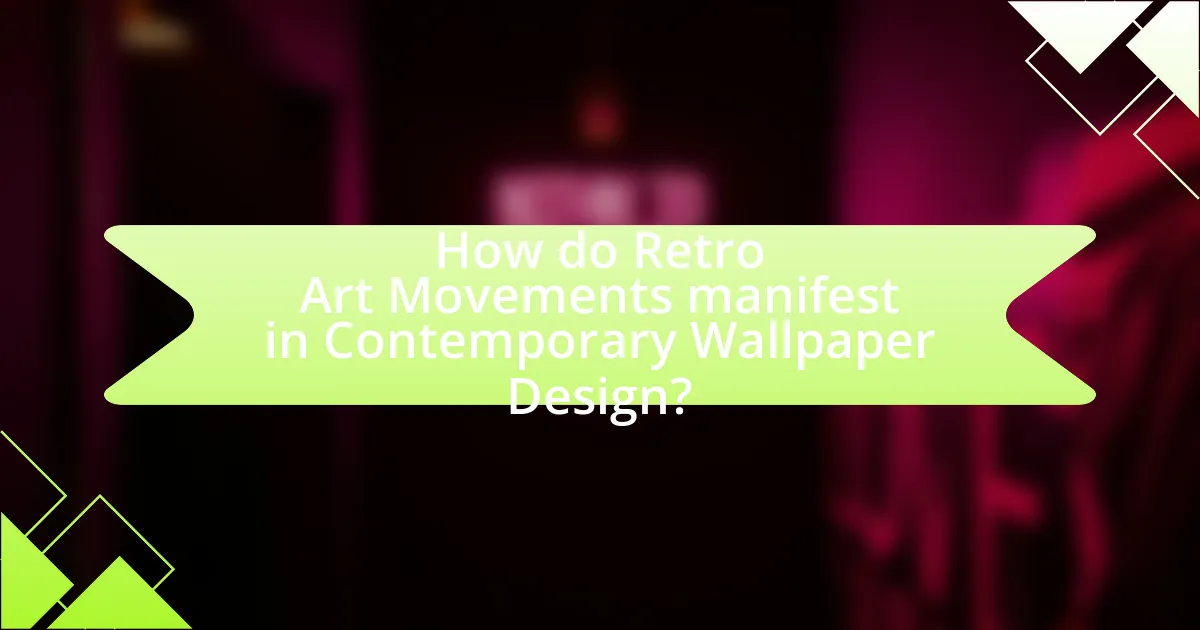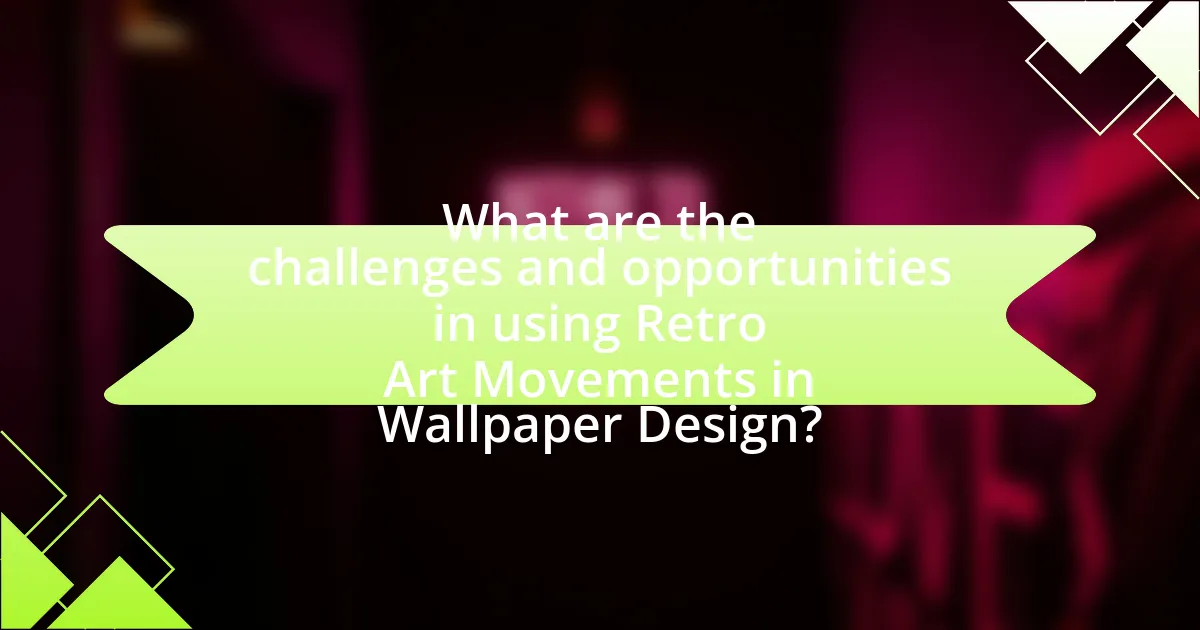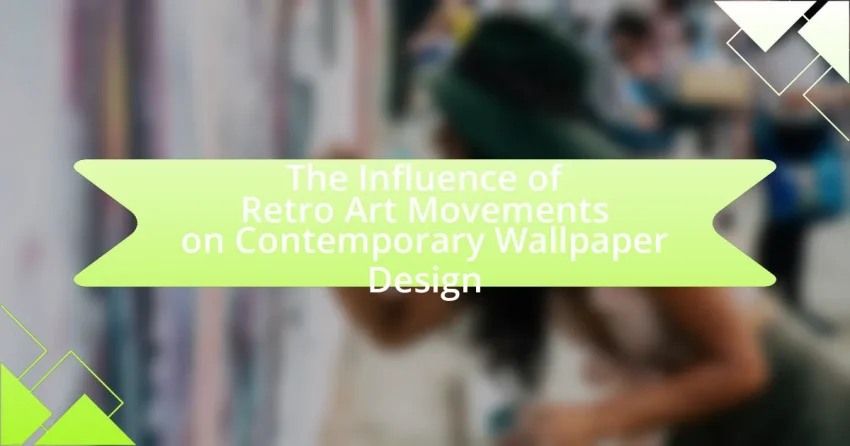The article examines the influence of Retro Art Movements on contemporary wallpaper design, highlighting key styles such as Pop Art, Mid-Century Modern, and Art Deco. It discusses the characteristics of these movements, including their use of vibrant colors, geometric patterns, and nostalgic themes, and how they have shaped modern design trends. The article also explores the impact of color palettes, patterns, and textures derived from retro styles, as well as the challenges and opportunities designers face when integrating these historical influences into contemporary aesthetics. Additionally, it addresses the cultural factors driving the resurgence of retro elements in design and offers practical tips for creating wallpaper that resonates with both nostalgia and modern sensibilities.

What are Retro Art Movements and Their Characteristics?
Retro art movements refer to artistic styles and trends that draw inspiration from past eras, particularly from the mid-20th century, characterized by vibrant colors, bold patterns, and nostalgic themes. These movements often include styles such as Pop Art, Mid-Century Modern, and Psychedelia, which emphasize playful aesthetics, geometric shapes, and a sense of whimsy. For example, Pop Art, emerging in the 1950s, utilized commercial imagery and mass media, while Mid-Century Modern design focused on simplicity and functionality, often incorporating organic forms and bright colors. The characteristics of these movements are evident in their use of repetitive motifs, a focus on consumer culture, and a celebration of everyday objects, which collectively influence contemporary design, including wallpaper patterns that reflect these historical styles.
How did Retro Art Movements influence design trends?
Retro art movements significantly influenced design trends by reintroducing bold colors, geometric patterns, and nostalgic themes into contemporary aesthetics. For instance, the Mid-Century Modern movement, characterized by its clean lines and organic forms, has inspired modern wallpaper designs that emphasize simplicity and functionality. Additionally, the Pop Art movement’s use of vibrant colors and commercial imagery has led to the incorporation of playful graphics and iconic motifs in wallpaper, appealing to a sense of nostalgia and cultural commentary. This resurgence of retro elements in design reflects a broader trend where designers draw from past styles to create innovative yet familiar visual experiences.
What specific styles emerged from Retro Art Movements?
Specific styles that emerged from Retro Art Movements include Pop Art, Mid-Century Modern, and Psychedelic Art. Pop Art, characterized by its bold colors and incorporation of popular culture elements, gained prominence in the 1950s and 1960s, with artists like Andy Warhol and Roy Lichtenstein leading the movement. Mid-Century Modern, which flourished from the 1940s to the 1960s, emphasized clean lines, organic forms, and a connection to nature, influencing furniture and interior design. Psychedelic Art, emerging in the 1960s, featured vibrant colors and surreal imagery, often associated with the counterculture movement and music festivals. These styles have significantly influenced contemporary wallpaper design, reflecting their enduring legacy in visual culture.
How do color palettes from Retro Art Movements impact design?
Color palettes from Retro Art Movements significantly impact design by evoking nostalgia and influencing contemporary aesthetics. These palettes, characterized by bold, vibrant colors and unique combinations, draw from historical styles such as Art Deco, Pop Art, and Mid-Century Modern, which have been shown to resonate with audiences seeking familiarity and emotional connection. For instance, the use of pastel colors in Mid-Century Modern design has been linked to a sense of calm and comfort, making it a popular choice in modern interior design. Additionally, studies indicate that color choices can affect consumer behavior; for example, a 2013 study published in the Journal of Experimental Psychology found that color can influence perceptions of brand personality, suggesting that retro color palettes can enhance brand identity in contemporary design.
Why are Retro Art Movements relevant to contemporary design?
Retro art movements are relevant to contemporary design because they provide a rich source of inspiration and aesthetic vocabulary that informs current creative practices. These movements, such as Art Deco, Pop Art, and Mid-Century Modern, have established iconic visual styles and color palettes that continue to resonate with designers today. For instance, the bold geometric patterns of Art Deco and the vibrant colors of Pop Art are frequently incorporated into modern wallpaper designs, reflecting a nostalgia that appeals to consumers. Additionally, the resurgence of interest in vintage aesthetics in the 21st century has led to a revival of these styles, as evidenced by the popularity of retro-themed interior design and products. This connection between past and present not only enriches the visual landscape but also fosters a sense of continuity in design history.
What cultural factors contribute to the resurgence of Retro Art Movements?
The resurgence of Retro Art Movements is primarily driven by nostalgia, cultural recycling, and the digital age’s influence on accessibility. Nostalgia for past aesthetics, particularly from the 1960s to the 1980s, creates a longing for simpler times, prompting artists and consumers to embrace retro styles. Cultural recycling, where past trends are reinterpreted and integrated into contemporary contexts, allows for a fresh take on established designs. Additionally, the digital age facilitates access to historical art movements through social media and online platforms, enabling widespread sharing and appreciation of retro styles. This combination of nostalgia, cultural recycling, and digital accessibility validates the resurgence of Retro Art Movements in contemporary design.
How do contemporary designers interpret Retro Art Movements?
Contemporary designers interpret Retro Art Movements by incorporating their distinctive styles, color palettes, and motifs into modern designs. For instance, the bold geometric patterns of the Bauhaus movement and the vibrant colors of Pop Art are frequently reimagined in wallpaper designs, creating a fusion of nostalgia and modern aesthetics. This approach not only pays homage to the original movements but also adapts them to current trends and technologies, such as digital printing techniques, which allow for intricate designs and customization. The resurgence of interest in mid-century modern design further exemplifies this interpretation, as designers draw inspiration from the simplicity and functionality of that era while infusing contemporary elements to appeal to today’s consumers.

How do Retro Art Movements manifest in Contemporary Wallpaper Design?
Retro art movements manifest in contemporary wallpaper design through the incorporation of bold colors, geometric patterns, and nostalgic motifs that reflect the aesthetics of past decades. Designers often draw inspiration from movements such as Art Deco, Mid-Century Modern, and Pop Art, utilizing vibrant palettes and stylized graphics that evoke a sense of nostalgia. For instance, the resurgence of floral patterns reminiscent of the 1960s and 70s can be seen in many modern wallpaper collections, showcasing a blend of vintage charm and contemporary sensibilities. This trend is supported by market research indicating a growing consumer preference for retro-inspired designs, as they provide a unique way to personalize spaces while connecting with historical artistic expressions.
What are the key elements of contemporary wallpaper influenced by Retro Art Movements?
Contemporary wallpaper influenced by Retro Art Movements features bold colors, geometric patterns, and nostalgic motifs. These elements reflect the aesthetics of movements such as Art Deco, Pop Art, and Mid-Century Modern, which emphasized vibrant designs and innovative use of materials. For instance, Art Deco’s emphasis on luxury and geometric shapes is evident in modern wallpapers that incorporate metallic finishes and symmetrical patterns. Similarly, the playful and vibrant colors characteristic of Pop Art are mirrored in contemporary designs that utilize bright hues and iconic imagery. The resurgence of these styles in wallpaper design demonstrates a continued appreciation for the visual language established by these historical movements.
How do patterns and motifs reflect Retro Art Movements in wallpaper design?
Patterns and motifs in wallpaper design reflect Retro Art Movements by incorporating distinctive visual elements and styles characteristic of those eras. For instance, the bold geometric shapes and vibrant colors of the Bauhaus movement are often mirrored in contemporary wallpaper, showcasing a revival of minimalism and functionality. Similarly, the organic forms and floral patterns from the Art Nouveau period are prevalent in modern designs, emphasizing nature and fluidity. Historical context supports this, as the resurgence of interest in mid-century modern aesthetics has led to a significant increase in wallpaper featuring retro patterns, with sales of such designs rising by over 30% in recent years. This demonstrates how contemporary wallpaper design not only pays homage to past movements but also adapts their principles to current trends.
What role does texture play in contemporary wallpaper inspired by Retro Art Movements?
Texture plays a crucial role in contemporary wallpaper inspired by Retro Art Movements by enhancing visual interest and evoking nostalgia. The use of varied textures, such as embossed patterns or fabric-like finishes, creates depth and tactile experiences that reflect the bold and experimental nature of movements like Art Deco and Pop Art. For instance, the incorporation of tactile elements in wallpaper designs can mimic the luxurious materials often found in retro interiors, thereby connecting modern spaces to historical aesthetics. This approach not only pays homage to the past but also engages contemporary consumers who seek unique and immersive environments.
What are the most popular Retro Art Movements influencing wallpaper today?
The most popular retro art movements influencing wallpaper today are Mid-Century Modern, Art Deco, and Pop Art. Mid-Century Modern, characterized by its clean lines and organic forms, has seen a resurgence in wallpaper designs that emphasize geometric patterns and vibrant colors. Art Deco, known for its luxurious materials and bold designs, influences contemporary wallpaper through intricate motifs and metallic finishes. Pop Art, with its focus on popular culture and bright, graphic imagery, inspires wallpapers that feature iconic imagery and playful designs. These movements are validated by current design trends that reflect a nostalgic appreciation for the aesthetics of the past, as seen in various interior design publications and exhibitions showcasing retro-inspired wallpaper collections.
How does Art Deco influence modern wallpaper designs?
Art Deco significantly influences modern wallpaper designs through its emphasis on geometric patterns, bold colors, and luxurious materials. This design movement, which emerged in the 1920s and 1930s, introduced stylized motifs and a sense of elegance that continues to resonate in contemporary wallpaper aesthetics. For instance, modern wallpapers often incorporate Art Deco-inspired elements such as chevrons, zigzags, and intricate floral designs, reflecting the movement’s characteristic symmetry and opulence. Additionally, the use of metallic finishes and rich textures in today’s wallpaper can be traced back to Art Deco’s focus on glamour and sophistication, showcasing how historical styles inform current design trends.
What aspects of Pop Art are incorporated into contemporary wallpaper?
Contemporary wallpaper incorporates aspects of Pop Art through bold colors, graphic imagery, and commercial themes. These elements reflect the vibrant aesthetic of Pop Art, which emerged in the 1950s and celebrated consumer culture and mass media. For instance, contemporary wallpaper often features iconic imagery from popular culture, such as comic book characters and advertisements, mirroring the techniques used by artists like Andy Warhol and Roy Lichtenstein. Additionally, the use of repetitive patterns and large-scale prints in wallpaper design echoes the Pop Art movement’s emphasis on visual impact and accessibility, making art a part of everyday life.

What are the challenges and opportunities in using Retro Art Movements in Wallpaper Design?
The challenges in using Retro Art Movements in wallpaper design include the risk of appearing outdated or clichéd, as well as the difficulty in balancing authenticity with modern aesthetics. Designers must navigate the fine line between homage and imitation, ensuring that the retro elements resonate with contemporary consumers while avoiding a sense of nostalgia that may not appeal to all demographics.
Conversely, the opportunities lie in the unique visual appeal and cultural significance that retro styles bring, which can attract consumers seeking distinctive and character-rich designs. For instance, the resurgence of mid-century modern patterns has been linked to a growing consumer interest in vintage aesthetics, as evidenced by market trends showing increased sales in retro-themed home decor. This intersection of nostalgia and modernity can create a compelling narrative that enhances brand identity and consumer engagement.
What challenges do designers face when integrating Retro Art Movements into wallpaper?
Designers face several challenges when integrating Retro Art Movements into wallpaper, primarily related to authenticity, aesthetic coherence, and market appeal. Authenticity is crucial as designers must accurately represent the historical styles and techniques of movements like Art Deco or Pop Art, which requires extensive research and understanding of the original context. Aesthetic coherence poses another challenge, as blending retro styles with modern design elements can lead to visual dissonance if not executed carefully. Additionally, market appeal is a significant concern; designers must ensure that the retro-inspired wallpaper resonates with contemporary consumers while maintaining the essence of the original art movement. These challenges highlight the delicate balance designers must achieve to create wallpaper that honors retro influences while remaining relevant in today’s market.
How can designers overcome the limitations of Retro Art Movements?
Designers can overcome the limitations of Retro Art Movements by integrating modern technology and contemporary design principles into their work. By utilizing digital tools, designers can reinterpret retro styles with enhanced flexibility, allowing for innovative patterns and textures that were not possible in traditional methods. For instance, advancements in printing technology enable the production of intricate designs that maintain the essence of retro aesthetics while offering durability and versatility. Additionally, incorporating current cultural themes and sustainability practices can further enrich the designs, making them relevant to today’s consumers. This approach not only honors the historical significance of retro movements but also adapts them to meet contemporary needs and preferences.
What opportunities arise from blending Retro Art Movements with modern aesthetics?
Blending Retro Art Movements with modern aesthetics creates opportunities for innovative design, unique visual narratives, and cultural resonance in contemporary wallpaper design. This fusion allows designers to draw inspiration from historical styles, such as Art Deco or Pop Art, while incorporating current trends and technologies, resulting in wallpapers that appeal to both nostalgia and modern sensibilities. For instance, the revival of bold colors and geometric patterns from the 1960s can be combined with contemporary materials and printing techniques, enhancing durability and visual impact. This approach not only attracts a diverse audience but also fosters a dialogue between past and present, enriching the design landscape.
What practical tips can be applied when designing contemporary wallpaper inspired by Retro Art Movements?
When designing contemporary wallpaper inspired by Retro Art Movements, focus on incorporating bold colors and geometric patterns characteristic of those eras. For instance, the use of vibrant hues, such as those seen in the 1960s Pop Art movement, can create striking visual appeal. Additionally, integrating motifs from specific movements, like Art Deco’s streamlined forms or the organic shapes of Art Nouveau, can enhance the design’s authenticity. Historical context is crucial; understanding the cultural significance of these movements can inform design choices, ensuring they resonate with contemporary aesthetics while paying homage to their origins.
How can one effectively choose colors and patterns for a Retro-inspired wallpaper design?
To effectively choose colors and patterns for a Retro-inspired wallpaper design, one should focus on iconic color palettes and geometric or floral patterns that reflect the specific retro era being emulated. For instance, the 1960s often featured bold colors like orange, yellow, and green, while the 1970s leaned towards earth tones and psychedelic patterns. Research indicates that these color choices and patterns evoke nostalgia and align with the aesthetic principles of the respective art movements, such as Pop Art and Mid-Century Modernism. By selecting colors and patterns that are historically accurate to the desired retro period, designers can create a cohesive and authentic wallpaper design that resonates with the intended audience.
What are the best practices for combining Retro styles with contemporary elements in wallpaper design?
The best practices for combining Retro styles with contemporary elements in wallpaper design include selecting a cohesive color palette, integrating geometric patterns, and balancing vintage motifs with modern textures. A cohesive color palette ensures that the retro colors harmonize with contemporary shades, creating a unified look. Integrating geometric patterns, which were prominent in retro designs, can add a modern twist when paired with minimalist contemporary elements. Balancing vintage motifs, such as floral or abstract designs, with sleek, modern textures like matte finishes or metallic accents enhances the overall aesthetic. These practices are supported by design principles that emphasize contrast and harmony, making the combination visually appealing and relevant in today’s interior design trends.
